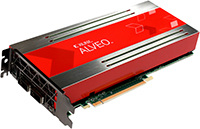Xilinx: FPGAs to accelerate data processing
Thomas Boudrot, Sr. Director Business Development of Xilinx closed the introductory session of new members. “My role today is to evangelize our FPGA know-how in the world of Data Center and HPC. Our turnover is $3 billion for 4,400 employees and more than 20,000 customers. We invented the Field Programmable Gates Array (FPGA) or programmable gate network in post-production stage about 30 years ago. We are active in 8 major markets: Telecoms, which still represent more than 60% of our revenue; but also Aerospace & Defense; Industrial & Medical; Test, Measurement & Emulation; Automotive & Transport; Audio, Video & Broadcast; Consumer; Data Center & HPC”.
 |
This last segment turned up to FPGA for the past 2 years. The very nature of the component is a massively parallel architecture, which makes it possible to respond better than traditional CPU-based architectures with ever-increasing processing needs. “That's why, rather than continuing to offer components, we have developed a PCI Express card-based acceleration platform, Alveo, that can be placed directly in any server to accelerate computing, networking or even storage”. |
The development of these solutions is due to several factors: we are moving from CPU-Centric to personalized and distributed computing; the advent of Artificial Intelligence and Machine Learning, coupled with other applications is changing the situation. “GPUs can do very well in Machine Learning alone, but if coupled to specific applications (genomic analysis; video encoding/decoding; compression/encryption...) then FPGA flexible structure becomes much more suitable. This is what we address with our acceleration cards that are deployed either in the Cloud (Microsoft Azure, Amazon, Alibaba, Tencent...), or On-Premises at the customer's site”.
Depending on the application, the FPGA acceleration factor for one single CPU can range from 5 to 90. For example, a genome analysis, which took 23 hours for the American specialist Illumina, is now reduced to 12 minutes by adding an FPGA-based acceleration card to the calculation server. We're approaching real time!
One of the obstacles mentioned to the use of the FPGA is the need for programming. The fact that it can only be programmed in VHDL or low-level language has limited its use to date. “At the beginning of October, we announced the Vitis software development platform dedicated to programming our FPGAs in C, C++, Python languages, capable of using libraries of Open Source mathematical functions, which will be mapped to our acceleration cores. And if you use frameworks for Machine Learning such as TensorFlow, Cafe or even FFmpeg for video and maintain these frameworks, our tool will directly convert your code and map it to our platforms, allowing users to target many applications such as Data Analytics, Image Processing, Video Processing, Machine Learning, Life Sciences & HPC, Financial Computing, using Open Source libraries or developed by specialized partners”.
|

